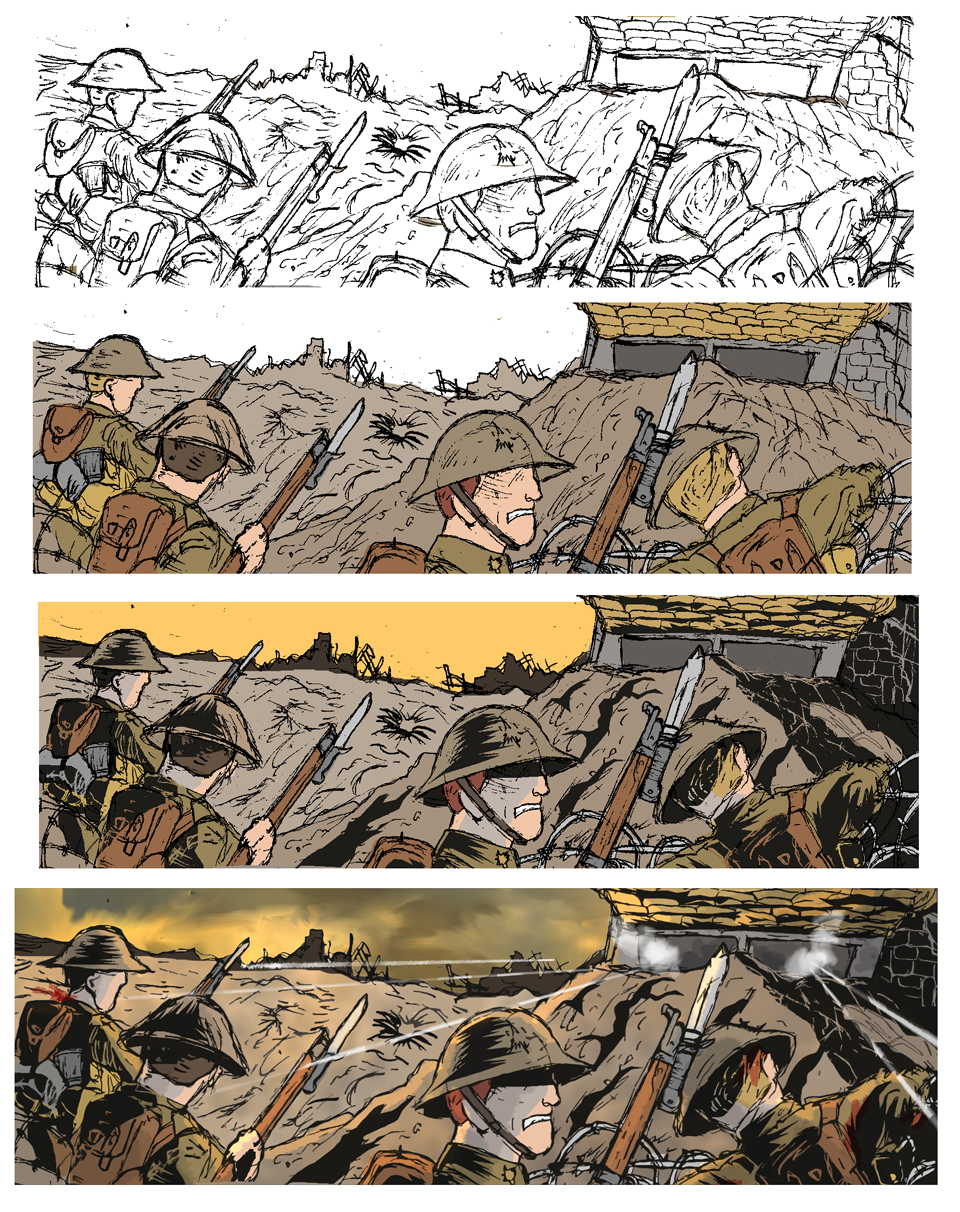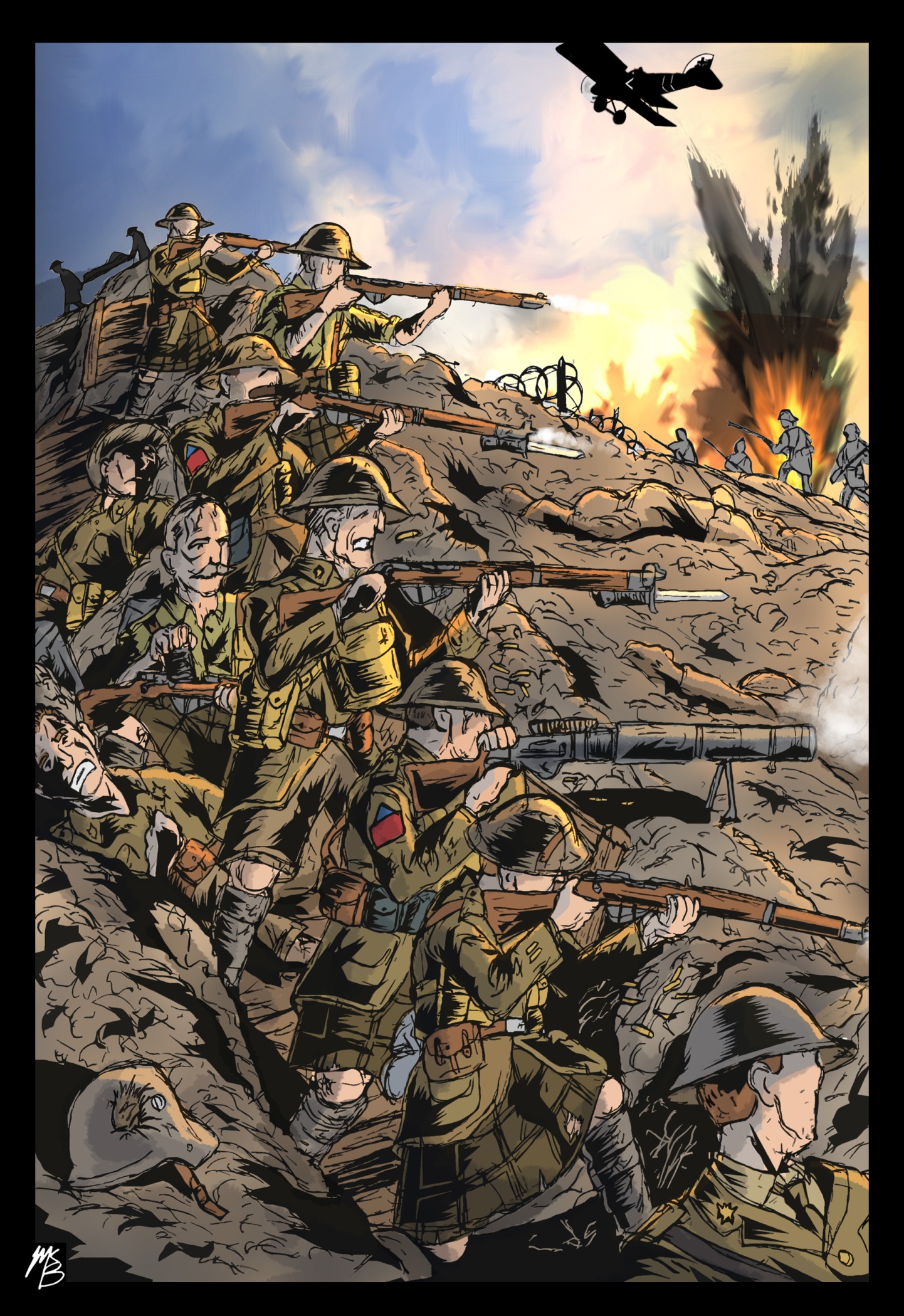Matt is an illustrator, animator and caricaturist. In his spare time he is also a doctoral student in the history department at Queen’s University. His academic work has appeared in
Journal of Canadian Studies,
Canadian Military Journal and
Canadian Military History.
Matt, it is wonderful to speak with you! I’d love to hear about how you began to explore art, and combine this passion with history.
Thanks, Cristina! I’m not sure which came first, my love of drawing or my love of history, but both have been my favorite hobbies as early as I can remember. As a kid, I was interested in every historical era from ancient times to the middle ages to the First World War. The more I read and learned about the past the more I was inspired to draw historical events and figures. Through university and into my graduate school work I found I had less time to devote to art so I particularly welcomed the opportunity to illustrate the graphic novel for the Hill 70 Project.
Have you done any other illustrated projects?
I am currently working on an illustrated
online project to profile every battalion commander in the Canadian Expeditionary Force. Along with a biography of the officers, I draw a caricature of each colonel. I’ve also experimented with animation, creating several short vignettes of historical battles, which can be found at my
YouTube channel.
I understand that the theme of shell-shock is a big part of your doctoral thesis, can you tell us a bit about that? Would you consider writing a graphic novel about your dissertation?
My research examines how notions of honour influenced Canadian perceptions of military service, death, and shell-shock during the First World War. Shell-shock is particularly interesting because its enigmatic nature challenged prevailing ideas about what constituted an honourable injury. I first became interested in this topic while volunteering at the Ontario Regiment Museum just prior to beginning my doctoral program. I transcribed a recently discovered letter written by Lieutenant Colonel Sam Sharpe of the 116th Battalion in which he admitted to creeping despair and depression following the deaths of so many men under his command. After suffering a nervous breakdown, he jumped to his death from a hospital window several months later on 25 May 1918. Sharpe’s story compelled me to explore the evolving and complex understandings of shell shock in greater depth. You can read more about Sharpe’s experience in my recently
published article for
Canadian Military History.
A graphic novel of my dissertation is a great idea! Since narrative is such a crucial part of history, illustrating the many fascinating stories of soldiers that I have uncovered would be a natural fit. I think a graphic novel is in fact a great source to teach people about history in a unique and creative way.
The Hill 70 Memorial commissioned a graphic novel, The Battle of Hill 70 in 2015. Can you introduce readers to the book?
The book tells the story of the first day of the Battle of Hill 70 through the eyes of Lieutenant Brock Chisholm of the 15th Battalion. By focusing on Chisholm’s experience leading his platoon, we highlight the significant impact of Hill 70 in shaping the future life of this young, twenty-two year old officer. As a result of Chisholm’s experiences in the trenches and witnessing the consequences of shell-shock, he studied psychiatry after the war and served as Director General of the Medical Services during the Second World War. In 1948, he became the first Director-General of World Health Organization.
Can you describe how you (and Robert) imagined the illustrations for the Hill 70 graphic novel?
Dr. Robert Engen, professor at RMC and senior researcher with the Hill 70 Project, developed the story focusing on Chisholm’s service. He provided me the general direction of the plot while allowing me the flexibility to imagine the visuals and flow. After drawing the panels and designing the pages, Rob added the text to guide the reader through the story.
How does the process go from there? What are the stages of illustration?
After sketching out the design of each page, I draw the panels by hand and then scan the images for digital colourization. Shading and shadows next create dimension and shape. The most critical stage is adding lighting and highlights in order to capture the atmosphere of the scene. I included an example to show how a panel moves from a basic pencil drawing to a complete illustration.
Through my illustrations, I aimed to create a unique style that readers would find compelling. Since the First World War is generally visualized as black-and-white in the popular imagination, colour and lighting were extremely important elements to create evocative imagery.
 Which was your favourite illustration or moment in The Battle of Hill 70?
Which was your favourite illustration or moment in The Battle of Hill 70?
My favorite would have to be the splash page of the 15th Battalion defending a newly captured trench against German counter-attacks. I hope the scale and detail of the illustration helps to convey the intensity and urgency of the battle.
 Do you read graphic novels yourself? If so, what are some of your favourites?
Do you read graphic novels yourself? If so, what are some of your favourites?
Although I do have an interest in comics, I actually haven’t read many graphic novels. But over the course of working on this project, one in particularly stands out both as an important influence and a real favourite.
Charley’s War, the best known First World War graphic novel, inspired the general tone and feel of my work. Written by Pat Mills and illustrated by Joe Colquhoun,
Charley’s War was originally published as a British comic strip serial between 1979 and 1986. Presented in stark black-and-white, the story follows a young private solider from the Battle of the Somme to the end of the war as he experiences all of the horrors of trenches warfare.
I hope my own graphic novel will inspire people to research more about Canadians’ experiences in the Great War and will pay tribute to all those who fought at Hill 70.
Thank you so much Matt, for sharing your passion with us!